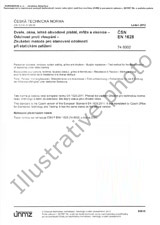We need your consent to use the individual data so that you can see information about your interests, among other things. Click "OK" to give your consent.
ČSN EN ISO 21268-4 (836230)
Soil quality - Leaching procedures for subsequent chemical and ecotoxicological testing of soil and soil-like materials - Part 4: Influence of pH on leaching with initial acid/base addition
Translate name
STANDARD published on 1.6.2020
The information about the standard:
Designation standards: ČSN EN ISO 21268-4
Classification mark: 836230
Catalog number: 509745
Publication date standards: 1.6.2020
SKU: NS-994086
The number of pages: 44
Approximate weight : 132 g (0.29 lbs)
Country: Czech technical standard
Category: Technical standards ČSN
The category - similar standards:
Annotation of standard text ČSN EN ISO 21268-4 (836230):
This document specifies a test to obtain information on the short- and long-term leaching behaviour and characteristic properties of materials.
The document has been developed to measure the pH-dependent release of inorganic and organic substances from soil and soil-like material as well as to produce eluates for subsequent ecotoxicological testing. For ecotoxicological testing, see ISO 15799 and ISO 17616. The equilibrium condition, as defined in this document, is established by the addition of predetermined amounts of acid or base to reach desired final pH values.
NOTE 1- Volatile organic substances include the low molecular weight substances in mixtures such as mineral oil.
NOTE 2 - It is not always possible to optimize test conditions simultaneously for inorganic and organic substances and optimum test conditions can also vary between different groups of organic substances. Test requirements for organic substances are generally more stringent than those for inorganic substances. The test conditions suitable for measuring the release of organic substances will generally also be applicable to inorganic substances.
NOTE 3 - Within the category of organic substances, a significant difference in behaviour exists between the more polar, relatively water-soluble compounds and apolar, hydrophobic organic substances (HOCs). In the latter case, mechanisms of release (e.g. particle-bound or dissolved organic carbon-bound) can be more crucial as well as sorption losses of soluble HOCs on different materials with which they come in contact (e.g. bottles, filters). The test and the results should be used for leaching of organic substances only with thorough consideration of the specific properties of the substances in question and the associated potential problems.
NOTE 4 - For ecotoxicological testing, eluates representing the release of both inorganic and organic substances are needed. In this document, ecotoxicological testing is meant to include genotoxicological testing.
The test method produces eluates, which can subsequently be characterized by physical, chemical and ecotoxicological methods in accordance with existing standard methods. The test is not suitable for substances that are volatile under ambient conditions.
For the purposes of ecotoxicological tests, the relevant pH range (see 8.2) will usually be pH 5 to pH 9.
This test is mainly aimed at being used for routine and control purposes, and it cannot be used alone to describe all leaching properties of a soil. Additional leaching tests are needed for that extended goal. This document does not address issues related to health and safety. It only determines the leaching properties outlined in Clause 5
Preview of the standard ČSN EN ISO 21268-4 (836230)
We recommend:
Technical standards updating
Do you want to make sure you use only the valid technical standards?
We can offer you a solution which will provide you a monthly overview concerning the updating of standards which you use.
Would you like to know more? Look at this page.




 Cookies
Cookies
